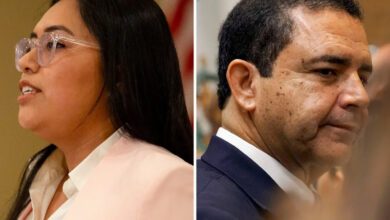SM City Council Place 5 Candidate Gregson Chats With SM Corridor News
Conducted by, Jarrett Moehn
Editor’s Note: The only portions of the interview below that were extracted was nonessential conversations that took place.
SM Corridor News did not correct any candidate on grammatical errors in the text below.
Question 1: Earlier this year, the current council members voted themselves a raise. If you’re elected and this comes up on an agenda, how would you vote and why?
Gregson: I don’t think I’d vote myself a raise. I think they’ve done it. It’s happened. I don’t think there’s any need to reconsider for the near future. I know that the workload of council is becoming much greater, but that’s really not why you’re serving, in some ways. You’re serving to serve the community. I do a lot of volunteer work. I’m on, over the past decade have been on 15 boards and commissions and I still serve on probably six or seven of those, both for public as well as private or civic. That’s just giving it my time.
Question 2: San Marcos is currently growing in population and business growth. Do you want San Marcos to continue this path and why?
Gregson: There’s two different elements of growth. One is people and one is prosperity. I want San Marcos to continue to grow, to be more prosperous. With respect to the growing number of people, even our own economic development group, GSMP, is hiring consultants that indicate that folks moving here have incomes that are less than the wages that our average citizen earns now. I think that is problematic. I’ve indicated that I’m apprehensive about the challenges that places on us as a community. More people mean more services, more food, more shelter, more clothing, more.
Those lower income levels require more social services, as well. With that said, I want to see more prosperity; I don’t necessarily want to see more growth. I want to see prosperous growth, rather than just people growth.
Question 3: If elected and the development for multifamily, single family and manufacturing came up for a vote, where would you want that development to be located to vote in favor, or vote against, on all 3 types of development?
Gregson: Let’s take each one. If you look at the intensity zones that the master plan calls for, there’re various areas of growth. There’s medical center, there’s south, there’s some places north, up near Yarrington. With respect to intense student housing, obviously I think close to an arterial would be important, I think as part of the intensity zones that we already have. Not anywhere near existing single-family neighborhoods.
As for residential developments, I’ve always been one that say, “The further out we go, the more soft-services, the more police and fire, we stretch those services.” We also stretch our transportation infrastructure. As we do that, then the costs go up exponentially. As we see that growth happen, I’m much more for defining a relative, putting a circle around where we want to grow and sticking within that circle. That’s really what the master plan calls for as well. To put something out miles away and then have to figure out a way to service it with police and fire protection.
For example, you look at the High Point PID that’s coming up. That’s a long way away. We’re already talking about the possibility to put a fire station out there. Fire stations cost four million dollars to build, they cost three million dollars to equip, and they cost a million and a half dollars a year to run. Those are expensive costs, and until I think we can utilize our … For example, if we do infill, we can serve the house within our own community. We already have a street running in front of, a waste water and water line running in front of, police and fire already go in front of those homes, our trash service already serves those homes.
It costs us very little incrementally to serve that development, but something way out, then we have to just really weigh the cost and benefit of what it will bring versus what it will cost us. Your last was industrial?
For Manufacturing, I know that there’s [inaudible 00:04:21] Barker that provide for that. Obviously, it’s a function of what kind of water needs they have. There’s certain areas that we have secondary or drain water that comes. It’s already been used, but it’s been processed to a certain level, but it can’t be used for public consumption. It’s not potable, but it’s still usable for, in some cases, manufacturing purposes. Obviously, it’s a function of the type of water user they are. We way need to suggest that they’re located closer to an existing pipe rather than having to build a pipe somewhere else for them. Like I said, Clovis Barker, I think there’s areas that are up to the north, up near Yarrington that are all ready to begin to be set for more commercial type of locations. Those are a couple of areas that I would say that those would be acceptable.
Question 4: Currently San Marcos is giving ‘incentives’ to businesses that want to relocate here. This benefits San Marcos, bringing more tax dollars into their coffers and it gives a chance to the lower income portion of our population to get better jobs, able to make more money, and receive better benefits.
One area the city council is overlooking is the small businesses that are popping up all the time, the entrepreneurs, i.e. the 1 to 5 employees or 1 man entrepreneur who takes on tremendous risks. If elected, what could you do for this entrepreneur group?
Gregson: Well, it’s interesting, because I’ve always been a strong proponent of small business here. I think quite frankly, were best equipped to handle small business growth versus we are going after large manufacturers or large companies. Not to say we shouldn’t do that, because I think we should. Let we go back. Some of your question sounded like and answer. It was in the form of a question.
I really think that the types of jobs that I’d like to incentivize are what I call career-oriented jobs. Jobs that not only provide above a living wage, but provide a trajectory of success for a family, so that they can raise their family, provide adequate food, shelter and clothing, be able to provide a quality education for their children, be able to put money away for a rainy day, and then ultimately for their retirement. Those jobs should be with benefits, like healthcare and educational benefits. Those are the types of jobs I’m willing to consider putting tax dollars to work as an investment for our community.
With respect to small businesses, right now, the way our current economic development incentive structure is put together, we don’t have the mechanism in place to fund a company, a startup like an Apple or a Google. I don’t mean the big company, I mean startups, like two students coming out of Texas State wanting to start up a young business, and us being able to provide some type of crucible if you will. Both from a space perspective as well as from a financial perspective, to provide them an opportunity to do that.
I’m a big proponent behind the co-working space that’s being discussed right across the street. Splash is what it’s going to be called. I know both the building owner and I know the person that’s putting together that deal, to have a collaborative, for lack of a better word I use it again, a crucible of creativity for young entrepreneurs to be here. I think that those type of things we need to look at as a city, and try to figure out how to create good opportunities for the students as they graduate, not only from out high school, but Texas State.
There’re needed jobs for the types of distribution facilities that we have. Like I said, we’ve got Amazon, we’ve got HEB has a big distribution facility, there are good living-wage jobs in those locations.
I would be hard-pressed to think that a student going to Texas State is going to school in anticipation of being to work at distribution job at HEB. I think that we have work to do as a city, to try to broaden the opportunities for all of our citizens, both those that need those types of jobs at the lower end and those that need the jobs that are career trajectory jobs that they have that chance for advancement, to go into senior management.
Question 5: Earlier this year the current city council had a tough time agreeing on the Greater San Marcos Partnership contract.
The GSMP contract comes up for renewal again around September of 2016, please explain why you would vote for or against renewing their contract and would you want to adjust the amount of funding the city invests with GSMP?
Gregson: Well, let me just talk about the history of that a bit. When that whole process first started out, I remember it was called partnership progress. I even remember back before that, it was a little bit more of a mess, and we were trying to get things started. We’d gone from leveraging our public dollars one to one, to three to one, to five to one this last year. At least that’s what I understand the commitment of GSMP is. They’re going to raise a million 550 thousand dollar budget. The city funds 360 thousand dollars of that. As I said, we’ve gone from one to one, to three to one, to five to one.
I like to leverage public dollars. I like to see our tax dollars put to work in a way that works better for us than one dollar can work, but you’re getting five dollars to work. From that perspective, I don’t really see a current need, based upon their current performance, to do that. Now, it’s a lot of money. 360 thousand dollars is not an inconsequential sum in the general fund budget of our city. I think that contract we looked at every year just as I would any spender to look at would make certain that we’re getting a good return on our investment. As long as we continue to see that type of leverage, and as long as we continue to get traction for the dollars we’re spending, then I don’t see any reason to change our course of action.
Well, obviously as a function of performance. If they stay the course, then I’ll be willing to stay the course.





